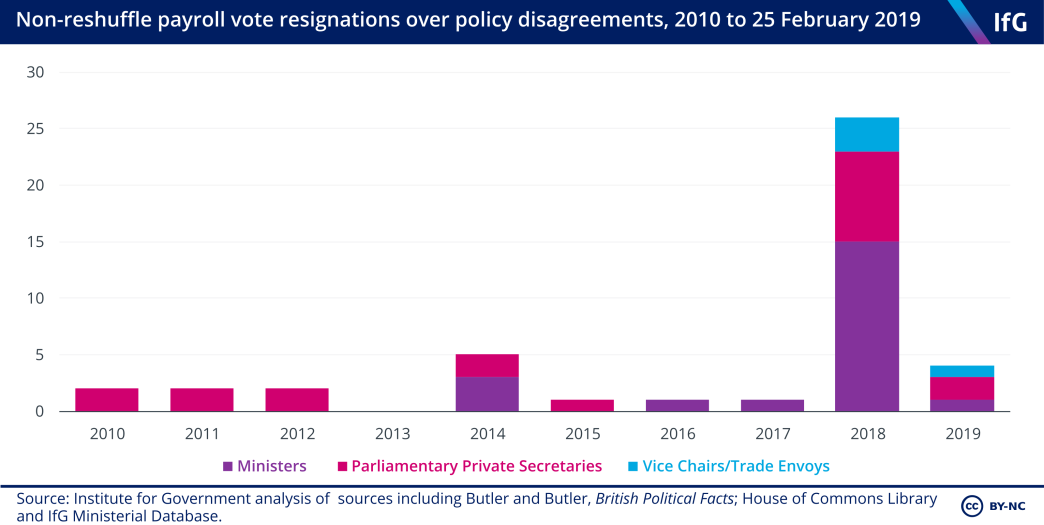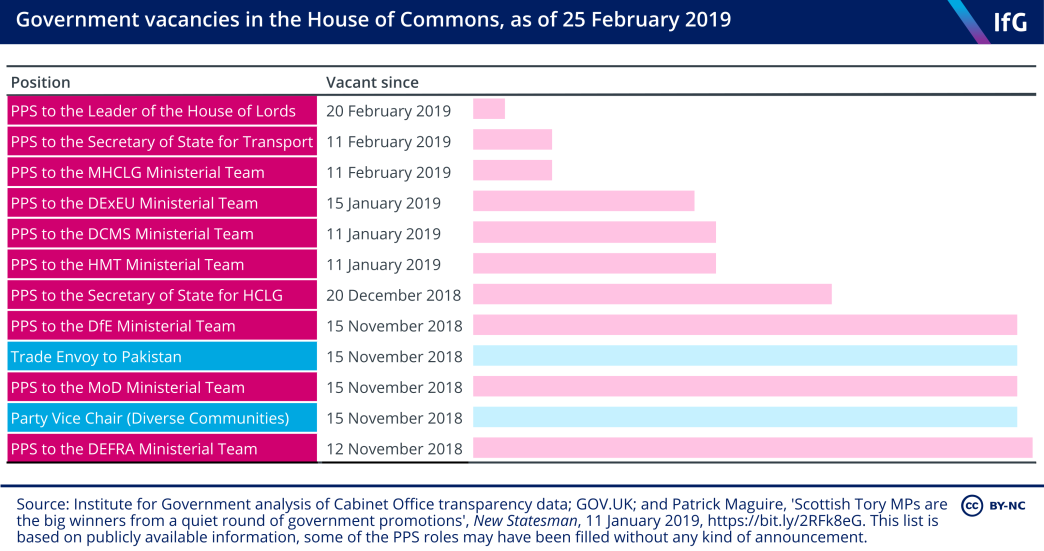Theresa May has a recruitment problem
The Prime Minister’s difficulties in replenishing the junior ranks of her government should be a cause for concern.
The Prime Minister’s difficulties in replenishing the junior ranks of her government should be a cause for concern, writes Alasdair de Costa.
A quick scan of various government departmental websites shows well-stocked teams of smiling ministers. But beneath the surface, all is not well. Positions below the top ranks of the Government appear to have been going unfilled, and look increasingly difficult to fill. The growing list of vacancies point to a failure in Theresa May’s deliberate attempts to increase the size of the wider payroll vote.
This is the catch-all term for MPs considered to be subject to Government patronage, including Ministers, Parliamentary Private Secretaries (PPSs), Conservative Party Vice-Chairs and the Prime Minister’s Trade Envoys. PPSs, who act as parliamentary aides for ministers, are obliged to vote with the Government, whilst trade envoys and vice-chairs are expected to support the Government but are not formally required to resign if they do not. Added together it makes for a bankable pool of votes, with critics arguing that the bloated payroll vote stifles Parliament’s ability to hold the executive to account.
Theresa May deliberately expanded the payroll vote
Not surprisingly, Theresa May had appeared keen to bolster the payroll vote’s size to encourage a greater proportion of her party to support her over key Brexit votes. In August 2017 it numbered just 149 MPs, but by November 2018 it had reached a record high of 174 MPs - an expansion that, it could be argued, poses a threat to Parliament’s independence.
However, the Prime Minister’s approach has begun to unravel. Twenty-six Conservative MPs have resigned from the payroll in the past year over Brexit, while six of the 19 Conservative trade envoys in the House of Commons voted against her on the Meaningful Vote. Since November, the size of the wider payroll vote has been in decline: it now stands at just 159 MPs.

The Government has not been filling vacancies to keep pace with the rate of resignations
Transparency around PPS appointments is poor, with no regularly updated list of Government PPSs found online and appointments not always announced. However, it looks as though an unprecedentedly high rate of payroll vote turnover has both created a raft of vacancies in the junior ranks of government and led to junior payroll MPs being promoted to fill vacancies higher up the ministerial ladder without new appointees announced to replace them.
Just five new MPs have been brought into the payroll vote since November, despite a total of 16 resignations in the same period, and there are now 12 junior government jobs which have not been announced as filled - including three as PPS to a Cabinet minister.
Not everyone is convinced by the value of PPSs, trade envoys and vice-chairs, but if the Prime Minister wanted to demonstrate that such roles are important to the functioning of government - rather than just fodder to pad out the wider payroll vote - then surely she would have attempted to fill them promptly? Her options, however, are increasingly limited.

The Government has a payroll recruitment problem
The slimness of the Prime Minister’s Parliamentary majority means the pool of MPs from which she can recruit new government figures was always small, but the scale of opposition to her Brexit policy has shrunk that pool still further. Excluding MPs who have voted against the Government over Brexit or been investigated for misconduct since the last election, the Prime Minister is left with just 44 backbench MPs to choose from.
And the Prime Minister has even fewer options when it comes to appointing PPSs. This post is traditionally the first step on the government ladder for young MPs with aspirations of ministerial office, and tends not to be offered to former ministers or MPs holding another parliamentary or government role. So this narrows the pool of potential appointees to just 11 MPs, of whom five are veteran MPs with at least 20 years of Parliamentary experience and a further two have recently left PPS positions. That leaves just four Conservative backbench MPs who fit the traditional profile of a prospective PPS.
The Prime Minister has little room to manoeuvre when it comes to her ability to replace rebellious ministers and PPSs, and with further ministers threatening to resign over the prospect of no-deal Brexit it may not be long before we start to see more government jobs lying vacant. This does not suggest a Government in good health. The shrinking of the wider payroll vote is healthy, as it better enables Parliament to properly scrutinise the Government, there must inevitably come a tipping point between effective Parliamentary scrutiny and effective Government.
- Topic
- Ministers
- Keywords
- Majority government
- Position
- Parliamentary private secretary
- Administration
- May government
- Publisher
- Institute for Government